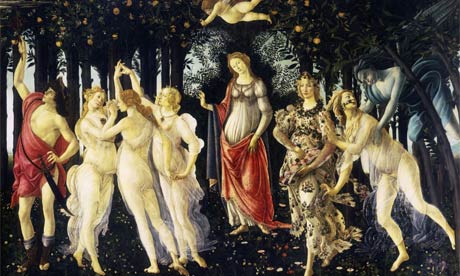Complete article
La Primavera (ca 1482), by Sandro Botticelli. Photograph: George Tatge/Alinari Archives/Corbis
...Very early in its history, Sandro Botticelli's depiction of the goddess Venus, raising her hand in blessing over a gathering of mythological followers, acquired the name it bears today: La Primavera. It's a lovely word, the Italian for spring – and there's a good chance this is what Botticelli called it when he first unveiled it to the Medicis in 1481...
Who does the season best? Monet and the impressionists captured spring's effervescent changes acutely. Van Gogh's paintings of fruit trees in blossom contain a desperate passion that is pure Vincent. William Blake, too, earns a place, for his picture of Chaucer's pilgrims heading out on a spring day, when April's sweet showers have ended the drought of March.
Botticelli's Primavera was one of the first large-scale European paintings to tell a story that was not Christian, replacing the agony of Easter with a pagan rite. The very idea of art as a pleasure, and not a sermon, began in this meadow. The painting teems with life: the myriad shades of the flowers in the dark grass have been analysed by botanists, who identified 200 accurately depicted plants. Blue-skinned Zephyrus, spirit of the wind, chases Chloris, who transforms into Flora in her flowering dress, while the Three Graces dance, Mercury waves a wand and Cupid gets ready to fire an arrow.
The goddess of love stands at the centre, crowned by radiating foliage against the blue sky. This is the season of Venus, when flowers bud and birds sing. In the world Botticelli inhabited, everyone lived close to nature whether they wanted to or not and the season of natural renewal was seen as a time for lovers and courtship. In Florence, young men cut down flowering boughs and pinned them to the doors of women they loved. (Botticelli's friend Poliziano even wrote a Renaissance pop song about spring lovers: "Welcome spring/ Which wants a guy to fall in love/ And you, girls/ Come to the fresh cool shade/ Of the green growing trees.")
The miracle of Botticelli's painting is that it translates all this life-renewing joy into colours and figures. The cool shade of the green trees sets off pale limbs, blond hair, gauzes and bright robes gliding over the carpet of flowers. The season is at once warmed by the sun and cooled by breezes. It is an image of life unstoppable...
Ω
